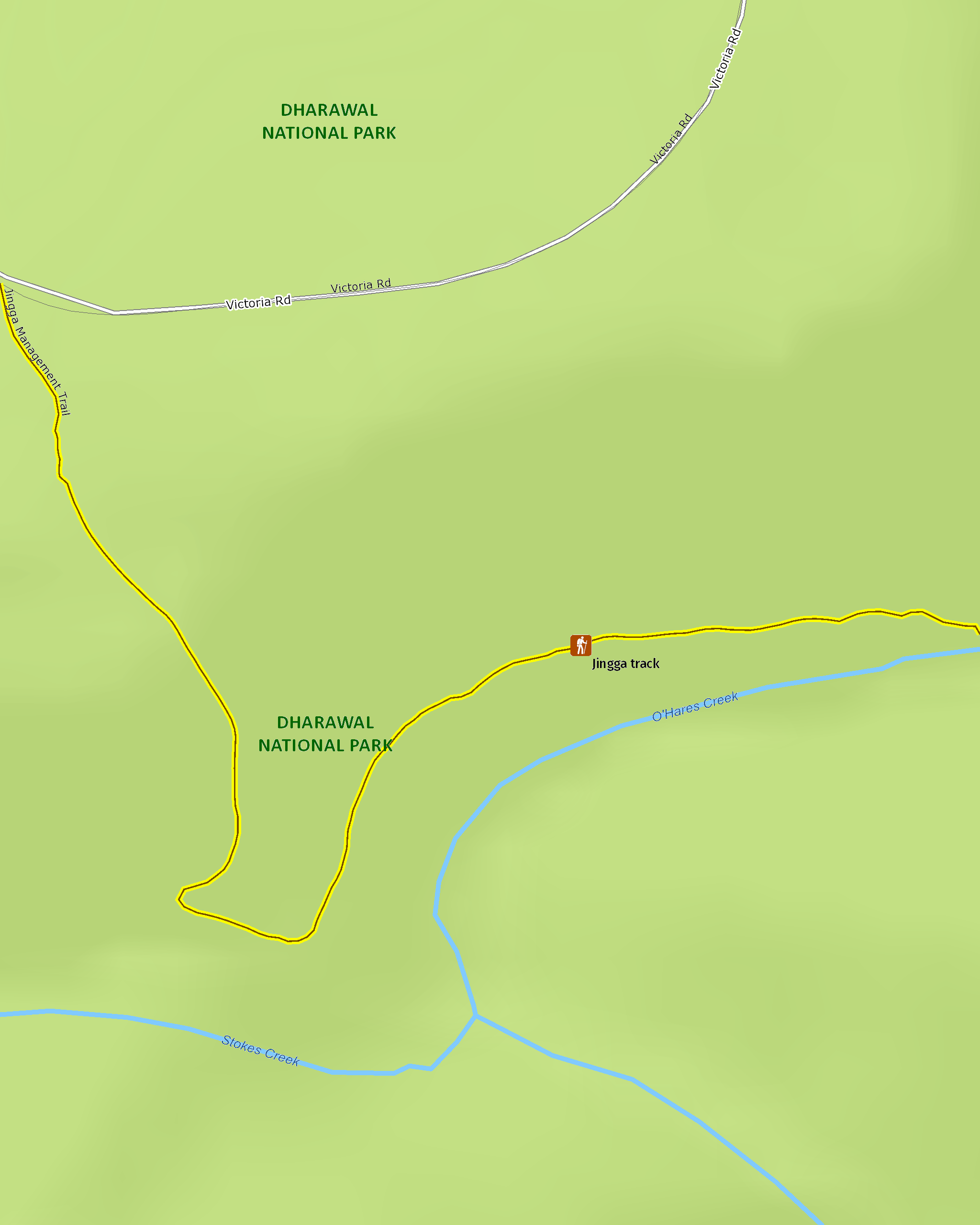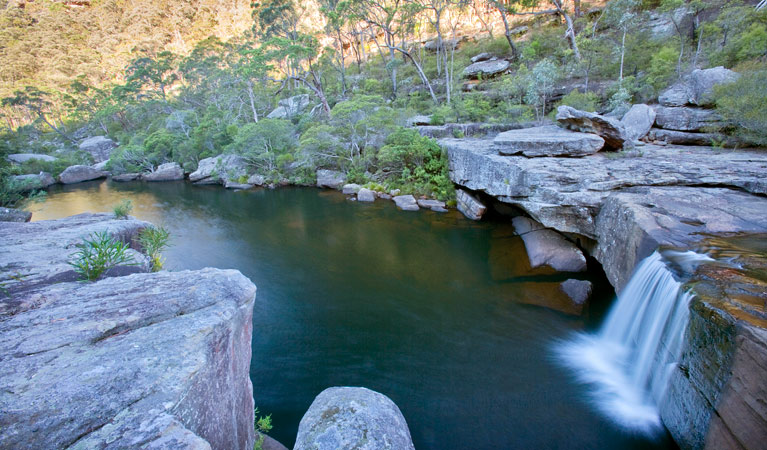Overview
Jingga walking track, in Dharawal National Park, is a short yet challenging walk to a waterhole, offering picnic and birdwatching opportunities.
- Accessibility
- No wheelchair access
- Distance
- 2.4km return
- Time suggested
- 1hr - 1hr 30min
- Grade
- Grade 3
- Opening times
Jingga walking track is open during daylight hours only.
- What to
bring - Drinking water, hat, sunscreen, suitable clothing, sturdy shoes, snacks
- Please note
- There are no toilets, drinking water, rubbish bins or picnic tables. Please take your rubbish with you.
- Please paddle cautiously and never dive into a waterhole as there are submerged logs and branches that you cannot see.
Jingga walking track in Dharawal National Park is a short steep walk through the traditional country of the Aboriginal Dharawal People, a landscape of eucalyptus bushland and dramatic sandstone formations.
In the language of the Dharawal, ‘jingga’ means ‘nice and sweet’ in relation to water. So it stands to reason that at the end of Jingga walking track, you’ll find a beautiful freshwater swimming hole, which is part of O’Hares Creek.
Pack a picnic and spend a few hours beside this large waterhole enjoying the natural setting. Bring along binoculars to get a better look at the birds and other animals of the area, many of which are rare or threatened species, such as long-nosed potoroos. One of the first marsupials to be described by European settlers, the long-nosed potoroo loves to dig up roots to eat.
Also see
-

O’Hares Creek lookout walking track
Gather the family and head to O’Hares Creek lookout walking track in Dharawal National Park, south of Campbelltown and near Appin. It’s a great getaway with scenic views and birdwatching.
Map

Map legend

Local alerts
For the latest updates on fires, closures and other alerts in this area, see https://www.nationalparks.nsw.gov.au/things-to-do/walking-tracks/jingga-walking-track/local-alerts
General enquiries
- National Parks Contact Centre
- 7am to 7pm daily
- 1300 072 757 (13000 PARKS) for the cost of a local call within Australia excluding mobiles
- parks.info@environment.nsw.gov.au
Park info
- in Dharawal National Park in the Sydney and surrounds and South Coast regions
Dharawal National Park is always open but may have to close at times due to poor weather or fire danger.
Visitor info
All the practical information you need to know about Jingga walking track.
Track grading
Features of this track
Distance
2.4km return
Time
1hr - 1hr 30min
Quality of markings
Clearly sign posted
Experience required
Some bushwalking experience recommended
Gradient
Short steep hills: Around 400m of the walk has very steep inclines and declines.
Quality of path
Formed track, some obstacles: The walk is a 4-5m-wide hard-packed ground management trail.
Steps
No steps: There are no steps along the main walking track, but there are 10 steps that lead onto a rock platform at the end of the walk.
Other barriers
Gates: There's a locked pipe swing vehicle gate towards the start of the walk, near Victoria Road. The gap around the gate is wide enough for pedestrians, but is not wide enough for prams, wheelchairs or mobility scooters.
Getting there and parking
Get driving directions
Jingga walking track is in the Victoria Road precinct of Dharawal National Park. To get there:
- From Campbelltown, follow Appin Road in a southerly direction, then turn left onto Woodland Road and follow until you reach a T-junction.
- Turn right onto Karrabul/Wedderburn Road and follow for 5km, then turn right onto Minerva Road which soon becomes Lysaght Road.
- After 2.5km on Minerva/Lysaght Road, turn left onto Victoria Road until you reach the end of the road.
- Walk past the gate and Jingga walking track is signposted on the left after about 400m
Parking
Parking is available in asphalt carparks at the end of Victoria Road, around 500m from the start of Jingga walking track. The carparks include 2 accessible parking spaces.
It can be a busy place on the weekend, so parking might be limited.
Best times to visit
Dharawal National Park is a great place to visit all year round. Head to the park for a refreshing dip during summer, a weekend picnic in the winter sun, some wildflower spotting during spring or an autumn walk or bike ride.
Weather, temperature and rainfall
Summer temperature
Average
17°C and 26°C
Highest recorded
42°C
Winter temperature
Average
6°C and 16°C
Lowest recorded
-0.6°C
Rainfall
Wettest month
March
Driest month
September
The area’s highest recorded rainfall in one day
254.5mm
Facilities
Toilets
There's an accessible non-flush toilet along Victoria Road, roughly 300m from the start of Jingga walking track. The toilet is set along a concrete footpath, with a ramp leading up to it.
- Non-flush toilets
Seats and resting points
There's a bench seat with a backrest at Victoria Road where the walk begins.
Maps and downloads
Accessibility
Disability access level - no wheelchair access
Parts of Jingga walking track may be challenging for people with reduced mobility:
- There's a locked vehicle gate at the start of the walk. It has enough space for pedestrians to go around it, but the gap isn't wide enough for prams, wheelchairs or mobility scooters.
- Around 400m of this walk has very steep inclines and declines
- There are 10 steps at the very end of the walk that lead onto a rock platform
There are accessible non-flush toilets around 300m from the start of the walk and 2 accessible parking spaces in the asphalt carpark on Victoria Road where this walk begins.
Prohibited
Camp fires and solid fuel burners
Pets
Pets and domestic animals (other than certified assistance animals) are not permitted. Find out which regional parks allow dog walking and see the pets in parks policy for more information.
Smoking
NSW national parks are no smoking areas.
Learn more
Jingga walking track is in Dharawal National Park. Here are just some of the reasons why this park is special:
A crucial catchment

O'Hares Creek catchment, on the Register of the National Estate is home to 17 vulnerable, rare or threatened species, and feeds the park's eucalypt forest, woodland, heathland, and sedgeland habitats. More than 500 plant species occur within the park, providing a home to a wide range of animals, including koalas and long-nosed potoroos, swamp wallabies, eastern wallaroos, New Holland honeyeaters and countless birds.
- Maddens Falls Enjoy scenic waterfall views at Maddens Falls lookout near Helensburgh, a great reward after a long bushwalk and the perfect place for birdwatching and photography.
- O’Hares Creek lookout walking track Gather the family and head to O’Hares Creek lookout walking track in Dharawal National Park, south of Campbelltown and near Appin. It’s a great getaway with scenic views and birdwatching.
Ancient landscapes

Dharawal National Park is the traditional land of the Dharawal Aboriginal people. Their long connection with this Country; the land and waterways, and the plants and animals that live in it feature in all facets of Aboriginal culture and are associated with Dreaming stories and cultural learning that is passed on today. The park protects several ancient Aboriginal sites, including drawings and axe-grinding grooves.
- Jingga walking track Jingga walking track, in Dharawal National Park, is a short yet challenging walk to a waterhole, offering picnic and birdwatching opportunities.
- Minerva Pool walking track Minerva Pool walking track winds through the traditional country of the Aboriginal Dharawal People. Enjoy a short bushwalk and then picnic at Minerva Pool, in Dharawal National Park, near Campbelltown.
Inspiring scenery

Prepare to be awed by the beautiful dense vegetation and rugged Hawkesbury sandstone that dominates the park's landscape. Set off on a bushwalk to discover eucalypt and shale forests, stunted woodlands and windswept heath. Explore further to find patches of rainforest and extensive sedgeland amongst the scenic terrain.
- 10B cycling trail 10B cycling trail in Dharawal National Park offers excellent easy cycling for enthusiastic bike riders, with a picturesque picnic spot along the way.
- Minerva Pool walking track Minerva Pool walking track winds through the traditional country of the Aboriginal Dharawal People. Enjoy a short bushwalk and then picnic at Minerva Pool, in Dharawal National Park, near Campbelltown.
- O'Hares Creek lookout For great gorge views near Campbelltown and Wollongong in southern Sydney, O'Hares Creek lookout in Dharawal National Park offers breathtaking scenery and birdwatching along a family-friendly walking track.
Park history

Dharawal was proclaimed a national park in 2012 following significant community involvement. Previously, it operated as a state conservation area and, before this, a water catchment area managed by Sydney Water. Seventy years of restricted public access has kept the area largely undisturbed, so pristine surroundings await you on your visit.
Plants and animals protected in this park
Animals
-

Swamp wallaby (Wallabia bicolor)
The swamp wallaby, also known as the black wallaby or black pademelon, lives in the dense understorey of rainforests, woodlands and dry sclerophyll forest along eastern Australia. This unique Australian macropod has a dark black-grey coat with a distinctive light-coloured cheek stripe.
-

Peron's tree frog (Litoria peroni)
Peron’s tree frog is found right across NSW. These tree-climbing and ground-dwelling Australian animals can quickly change colour, ranging from pale green-grey by day, to a reddish brown with emerald green flecks at night. The male frog has a drill-like call, which has been described as a 'maniacal cackle’.
-

Sugar glider (Petaurus breviceps)
The sugar glider is a tree-dwelling Australian native marsupial, found in tall eucalypt forests and woodlands along eastern NSW. The nocturnal sugar glider feeds on insects and birds, and satisfies its sweet tooth with nectar and pollens.
-

Southern boobook (Ninox novaeseelandiae)
The southern boobook, also known as the mopoke, is the smallest and most common native owl in Australia. With a musical 'boo-book' call that echoes through forests and woodlands, the southern boobook is a great one to look out for while bird watching.
-

Eastern water dragon (Intellagama lesueurii lesueurii)
The eastern water dragon is a subaquatic lizard found in healthy waterways along eastern NSW, from Nowra to halfway up the Cape York Pensinsula. It’s believed to be one of the oldest of Australian reptiles, remaining virtually unchanged for over 20 million years.

